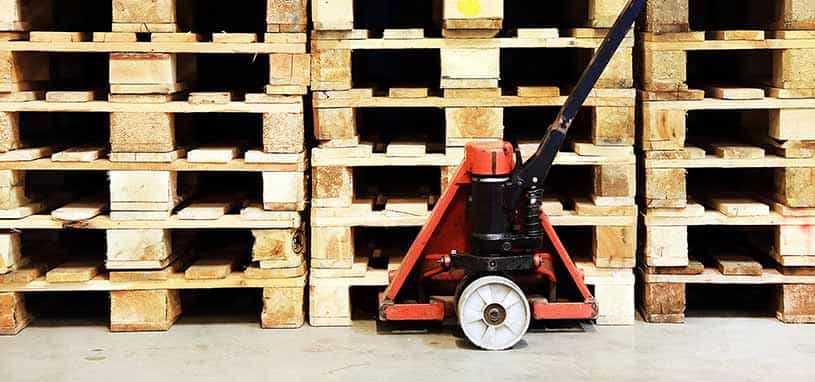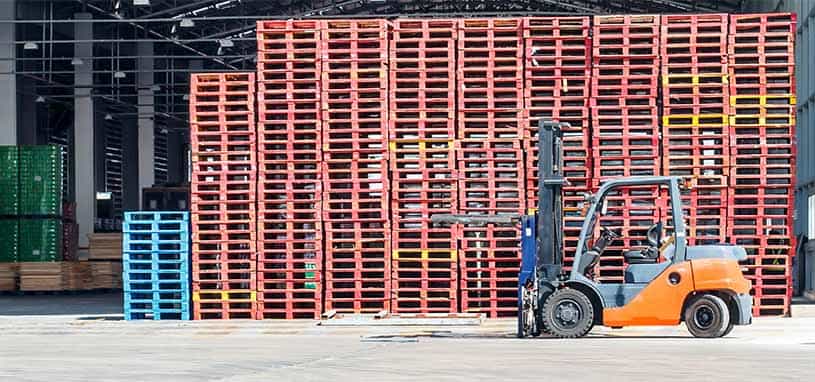Stacking and storing pallets safely
Pallets are a widely used method for storing and transporting products and materials in both small and large scale operations. It's estimated that up to 80% of commercial goods are carried on pallets at some point in their lifecycle.
However, pallets can also be misused. When they're not handled properly, pallets become damaged and create and become a hazard in the workplace. Care must be taken when stacking and storing pallets to avoid injuries and the loss of product.
Plain Pallets is a trusted supplier of new wooden pallets as well as used wooden pallets. We are also a source of expert knowledge when it comes to safety and the efficient handling of pallets.
Handling guidelines for empty pallets

Moving empty pallets out of the way and stacking them for reuse is an important part of pallet handling. Without steady control over empty pallets, there is a risk of creating housekeeping problems and the potential for safety incidents.
At the same time, we lose valuable time moving pallets around in a rush when we need them. It is far more efficient to have them readily available to us in neatly stacked piles.
Best practice for storing empty pallets is to keep stacks at below shoulder height. This keeps workers in a good ergonomic range if pallets are to be manually handled.
It is also worth doing a pallet inspection whenever a pallet is delivered to the empty pallet stack. This creates an opportunity to take unsafe pallets out of service before they are reused. Plain Pallets has a refurbishment division for repairing pallets and putting them back to safe use.
Which racking is best for your business?
Choosing the best pallet racking for your business can make the difference between easy and efficient operations or continuous frustration. The first step to choosing a pallet racking option is to understand your business needs:
- How much stock do you move through your facility and how quickly does it move?
- What are the weight requirements for a fully loaded pallet and a fully loaded pallet rack?
A variety of options are available, and it is advisable to seek advice from suppliers of both pallet racking and pallet handling equipment as it is the combination of these that will give you the optimum storage arrangement.
Selective Pallet Racking is the most common solution. It is only one pallet deep but can be configured back to back for maximum storage.
Double Deep Pallet Racking allows for storing two pallets one behind the other on a single rack. The arrangement increases total storage capacity but requires specialised pallet handling equipment and accesses stock on a last in first out system (LIFO)
Drive in racking enables storing multiple pallets one behind the other. A forklift drives into the rack and adds each new pallet in front of the previous one. This system is often used for cold storage applications.
Pallet handling equipment and where to use it

Pallet jacks are wheeled trolleys operated by a single operator. They are suitable for small scale operations, moving pallets inside a trailer or where pallets are moved over short distances.
The forklift is the primary pallet handling equipment used in most pallet storage applications. Hydraulic attachments can enable a standard forklift to reach into a double deep rack, but the loading capacity is reduced because the weight tends towards tipping the forklift over.
Reach trucks are designed to operate in narrow aisles. Their compact design keeps the pallet closer to the body of the truck and they have a smaller turning radius. Pantographic reach trucks use a scissor design to extend their reach into a double deep rack.
Safety tips for handling wooden pallets
Wooden pallets are heavily used for storage and transport, but they can be damaged and cause injuries if they are not handled correctly. This can be as simple as a splinter or abrasion from rough wooden surfaces, or as hazardous as being crushed by an unbalanced load. Here are a few basic safety tips for handling wooden pallets:
- Inspect pallets before use.
- Make sure they are evenly loaded and not overloaded during use.
- Stack empty pallets below shoulder height.
- Ask for help when moving empty pallets.
- Use the right PPE - like gloves and safety boots.
Why choose Plain Pallets for your new and used wooden pallets?
Plain Pallets has been supplying wooden pallets to the Australian market for over 40 years. We refurbish used pallets and offer expert advice related to all your pallet needs.
Find out more about Plain Pallets and how our new and used pallets can help you business.
Must Read
Plain Pallets on 29 April 2014
How to Get Greater Mileage out of Your Pallets
Do your pallets go the distance? If not, you may be losing money through replacement costs and damaged goods. Get the most out of your pallets ...
Read morePlain Pallets on 11 March 2014
Plain Pallets Display the Future of Sustainability
Pallets are always useful. See the many ways old pallets can be reused. Who knows, maybe your next house or business will have some great pallet furniture! ...
Read more